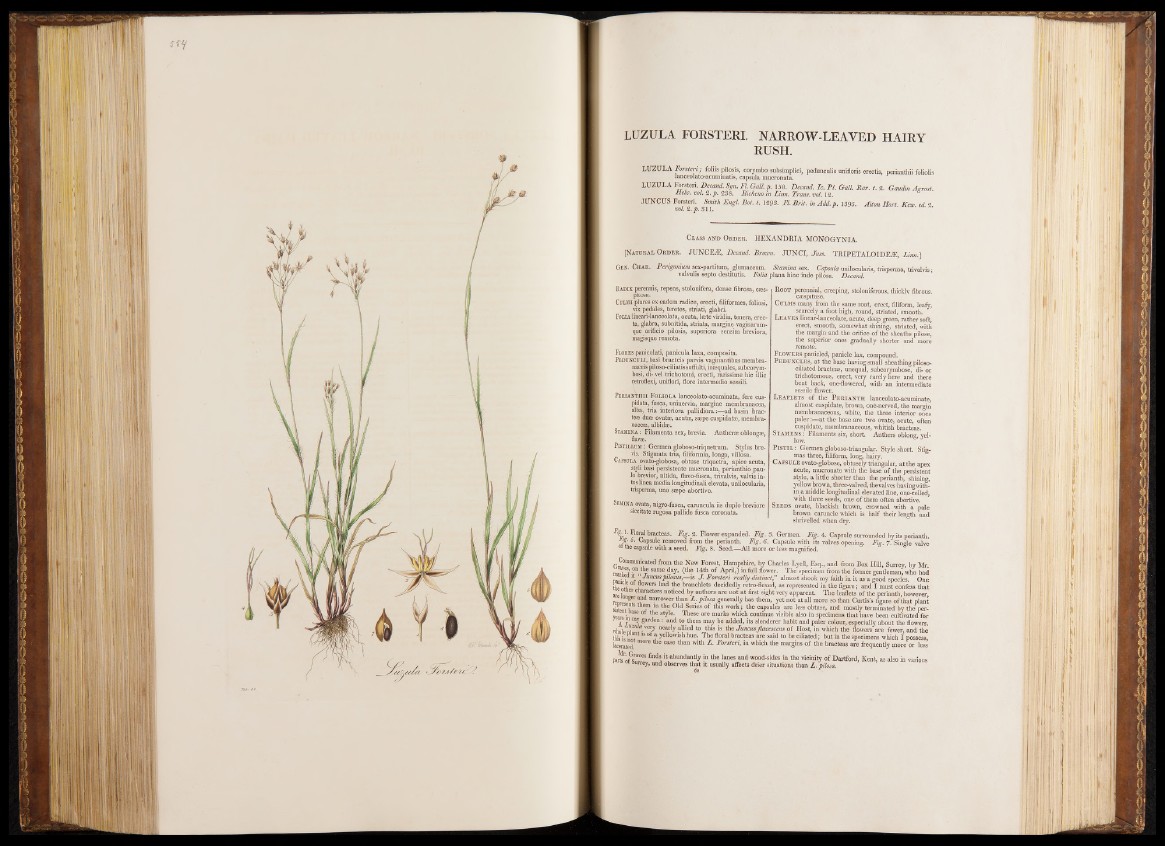
LUZULA FÖRSTER! NARROW-LEAVED HAIRY
RUSH.
LUZULA Forsteri ; foliis pilosis, corymbo subsimplici, pedunculis unifloris erectis, perianth» foliolis
lanceolato-acuminatis, capsula mucronata.
LUZULA Forsten. Decand. Spn. FI. Gall. p. 150. Decani. Ic. P I. Gall. Ear. t. 2 . Gaudin Auront.
Helv. vol. 2. p . 238. Ficheno in Linn. Trans, vol. 12 .
JUNCUS Forsteri. Smith Engl. Bot. t. 1293. Fl. B rit. in Adi. p . 1395. Alton Hort. K m . ed. 2.
vol. 2 .p . SU .
Class a nd Ord e r . HEXANDRIA MONOGYNIA.
[Natural Ord e r . JUNCEjE, Decand. Brown. JUNCI, Juss. TRIPETALOIDEjE, Linn }
Gen. Char. Perigonium sex-partitum, glumaceum. Stamina sex. Capsula unilocularis, trisperma, trivalvis •
valvulis septo destitutis. Folia plana hinc inde pilosa. Decand.
Radix perennis, repens, stolonifera, dense fibrosa, cæs-
pitosa.
CuiMI plures ex eadem radice, erecti, filiformes, foliosi,
vix pedales, teretes, striati, glabri.
Folia lineari-lanceolata, acuta, læte viridia, tenera, erec-
ta, glabra, subnitida, striata, margine vaginarum-
que orificio pilosis, superiora sensim breviora,
magisque remota.
Flores paniculati, panicula laxa, composita.
Pedunculi, basi bracteis parvis vaginantibus membra-
naceis piloso-ciliatissuffulti, inoequales, subcorym-
bosi, di- vel trichotomi, erecti, rarissime hic illic
retroflexi, uniflori, flore intermedio sessili.
PeriantHi i Foliola lanceolato-acuminata, fere cus-
pidata, fusca, uninervia, margine membranacea,
alba, tria interiora pallidiora:—-ad basin brac-
teæ duoe ovatoe, acutæ, sæpe cuspidate, membra-
naceæ, albidæ.
Stamina : Filamenta sex, brévia. Antheræ oblongæ,
flavæ.
Pistillijm : Germen globoso-triquetrum. Stylus brevis.
Stigmata tna, filiformia, longa, villosa.
Capsula ovato-globosa, obtuse triquetra, apice acuta,
styli bàsi persistente mucronata, perianthio pau-
lo brevior, nitida, flavo-fusca, trivalvis, valvis in-
tus linea media longitudinali elevata, unilocularis,
trisperma, uno sæpe abortivo.
Semina oyata, nigro-fusca, caruncula iis duplo breviore
siccitate rugosa pallide fusca coronata.
ty ') - Floral brae teas. Fig. 2. Flower expanded. Fig.
-%• 5. Capsule removed from the perianth. Fig. 6.
of the capsule with a seed. Fig. 8. Seed.—All more
Root perennial, creeping, stoloniferous, thickly fibrous,
csespitose.
Culms many from the same root, erect, filiform, leafy,
scarcely a foot high, round, striated, smooth.
L eaves linear-lanceolate, acute, deep green, rather soft,
erect, smooth, somewhat shining, striated, with
the margin and the orifice o f the sheaths pilose,
the superior ones gradually shorter and more
remote.
Flowers panicled, panicle lax, compound.
Peduncles, at the base having small sheathing piloso-
ciliated bracteas, unequal, subcorymbose, di- or
trichotomous, erect, very rarely here and there
bent back, one-flowered, with an intermediate
sessile flower.
Leaflets of the Pe r ia n t h lanceolato-acuminate,
almost cuspidate, brown, onb-nerved, the margin
membranaceous, white, the three interior ones
paler:—a t the base are two ovate, acute, often
cuspidate, membranaceous, whitish bracteas.
Stamens : Filaments six, short. Anthers oblong, yellow.
Pis t il : Germen globoso-triangular. Style short. Stigmas
three, filiform, long, hairy.
Capsule ovato-globose, obtusely triangular, at the apex
acute, mucronate with the base of the persistent
style, a little shorter than the perianth, shining,
yellow brown, three-valved, the valves having within
a middle longitudinal elevated line, oqe-celled,
with three seeds, one of them often abortive.
Seeds ovate, blackish brown, crowned with a pale
brown caruncle which is half their length and
shrivelled when dry.
3. Germen. | Fig. 4. Capsule surrounded by its perianth.
Capsule with its valves opening. Fig. 7. Single valve
or less magnified.
Communicated from the New Forest, Hampshire, by Charles Lyell, Esq., and from Box Hill, Surrey bv Mr
Craves, 0n the same day, (the 14th of April,) in full flower --------s-----a— . . . . ■■ 3 A . :
d it “ Juncus pilosus,—is J . Forsten The specimen from the former gentleman, who had
really distinct,” almost shook my faith in it as a good species. One
the nth» k . urauuueis ueciuemy reiro-nexen, as represented in the Ugure; and I must confess that
are Inn <™ cters noticed by authors are not at first sight very apparent. The leaflets o f the perianth, however,
r eo r eS P narrower than L . pilosa generally has them, yet not at all more so than Curtis’s figure of that plant
sistent h? f j n th® 01d_Senes of this work; the capsules are less obtuse, and mostly terminated by the per-
Years in “ a Sty e\ These are marks whlch continue visible also in specimens that have been cultivated for
j in my garden: and to them may be added, its slenderer habit and paler colour, especially about the flowers,
»hole ntf1? Te7 nef rly *° this is ffif Junauflaocscens of Host, in which the flowers are fewer, and the
thi9 i, ls °* * yetl°™ h hue. The floral bracteas are said to be ciliated; but in the specimens which I possess,
Crated m°re CSSe mtl1 L ’ F m lm ’ in which ,be margins of the bracteas are frequently inore or less
iHf it* bunda“tly >n •!“ lanes and wood-sides in the vicinity of Dartford, Kent, as also in various
Surrey, and observes that it usually affects drier situations than L . pilosa.